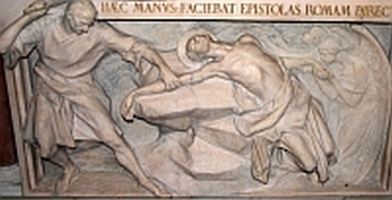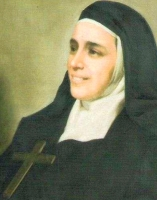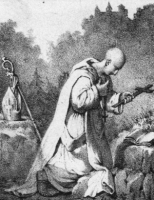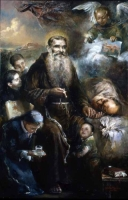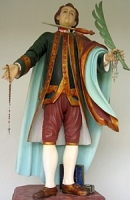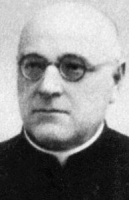St. Joseph Hien
Feastday: June 27
Death: 1840
Canonized: Pope John Paul II
Dominican martyr of Vietnam. He was beheaded by anti-Christian authorities and was canonized in 1988 by Pope John Paul II.
St. John Southworth
Born c. 1592
Lancashire, England
Died 28 June 1654
Tyburn, London, England
Venerated in Catholic Church
Beatified 15 December 1929, Rome by Pope Pius XI
Canonized 25 October 1970, Rome by Pope Paul VI
Major shrine Westminster Cathedral
Feast 27 June (Diocese of Westminster, 25 October (with the Forty Martyrs of England and Wales)
Attributes chasuble, martyr's palm
Patronage priests
One of the Forty Martyrs of England and Wales. He was born in Lancashire and became a priest in 1619 in Douai. Sent to England that same year, he was arrested but released through the intercession of Queen Henrietta Maria. He joined St. Henry Morse, subsequently working diligently during the plague of 1636. Arrested again, he was martyred by being hanged, drawn, and quartered at Tybum. His relics are in Westminster Cathedral in London, discovered there in 1927. Pope Paul VI canonized him in 1970.
John Southworth (c. 1592, Lancashire, England - 28 June 1654, Tyburn, London) was an English Catholic martyr. He is one of the Forty Martyrs of England and Wales.
History
John Southworth came from a Lancashire family who lived at Samlesbury Hall. They chose to pay heavy fines rather than give up the Catholic faith.[1]
He studied at the English College in Douai, in northern France. (The college later relocated to St Edmund's College, Ware in Hertfordshire.) In 1585 a law had been passed branding as treasonable any priest who dared to come back to England. The law was later extended to all who assisted such priests.
Southworth was ordained priest before he returned to England 13 October 1619,[2] where he remained until 1624,[1] when he was then recalled to serve as chaplain to Benedictine nuns in Brussels.[3]
After about a year, he returned to Lancashire, where he was arrested in 1627 and imprisoned in Lancaster Castle along with Edmund Arrowsmith. Arrowsmith was hanged, drawn, and quartered at Lancaster on 28 August 1628.[4] Southworth was later moved to The Clink in London. He was sentenced to death for professing the Catholic faith, but in 1630, at the insistence of Queen Henrietta Maria, he and seventeen others were delivered to the French ambassador and deported to France.[3]
By 1636 he had returned to England and lived in Clerkenwell, London, during a plague epidemic. He and Henry Morse ministered to the sick in Westminster,[5] and raised money for the families of victims. Southworth was arrested again in November 1637 and sent to the Gatehouse Prison and again transferred to The Clink, where he remained for three years.[2] Four times Southworth was arrested, and three times released by the Secretary of State Sir Francis Windebank at the direction of the Queen. The fourth time he managed to escape.[3] From 1640 and 1654 he continued his clandestine ministry.[1]
He was again arrested under the Interregnum and was tried at the Old Bailey under Elizabethan anti-priest legislation. He pleaded guilty to exercising the priesthood and was sentenced to be hanged, drawn and quartered. He was executed at Tyburn, London.[2]
The Spanish ambassador returned his corpse to Douai for burial.[6] His corpse was sewn together and parboiled, to preserve it. Following the French Revolution, his body was buried in an unmarked grave for its protection. The grave was discovered in 1927 and his remains were returned to England. They are now kept in the Chapel of St George and the English Martyrs in Westminster Cathedral in London.
Veneration
Reliquary of Saint John Southworth in Westminster Cathedral.
He was beatified in 1929. In 1970, he was canonized by Pope Paul VI as one of the Forty Martyrs of England and Wales.[6] His feast day is 27 June celebrated in the Westminster diocese.[6] He is a patron saint of priests.[7]
In 2014, The Guild of Saint John Southworth was established in Westminster Cathedral. Its members are volunteers who will meet visitors, answer their questions and guide them around the cathedral if they wish. This service is free.
St. Deodatus
Feastday: June 27
Death: 473
A bishop of Nola, in Italy. He was the successor of St. Paulinus. His relics were translated to Benevento in 839.
Our Lady of Perpetual Help
Also known as
Our Lady of Perpetual Succour
About
The picture of Our Lady of Perpetual Succour is painted on wood, with background of gold. It is Byzantine in style and is supposed to have been painted in the thirteenth century. It represents the Mother of God holding the Divine Child while the Archangels Michael and Gabriel present before Him the instruments of His Passion. Over the figures in the picture are some Greek letters which form the abbreviated words Mother of God, Jesus Christ, Archangel Michael, and Archangel Gabriel respectively.
It was brought to Rome towards the end of the fifteenth century by a pious merchant, who, dying there, ordered by his will that the picture should be exposed in a church for public veneration. It was exposed in the church of San Matteo, Via Merulana, between Saint Mary Major and Saint John Lateran. Crowds flocked to this church, and for nearly three hundred years many graces were obtained through the intercession of the Blessed Virgin. The picture was then popularly called the Madonna di San Matteo. The church was served for a time by the Hermits of Saint Augustine, who had sheltered their Irish brethren in their distress.
These Augustinians were still in charge when the French invaded Rome, Italy in 1812 and destroyed the church. The picture disappeared; it remained hidden and neglected for over forty years, but a series of providential circumstances between 1863 and 1865 led to its discovery in an oratory of the Augustinian Fathers at Santa Maria in Posterula. The pope, Pius IX, who as a boy had prayed before the picture in San Matteo, became interested in the discovery and in a letter dated 11 Dececember 1865 to Father General Mauron, C.SS.R., ordered that Our Lady of Perpetual Succour should be again publicly venerated in Via Merulana, and this time at the new church of Saint Alphonsus. The ruins of San Matteo were in the grounds of the Redemptorist Convent. This was but the first favour of the Holy Father towards the picture. He approved of the solemn translation of the picture (26 April 1866), and its coronation by the Vatican Chapter (23 June 1867). He fixed the feast as duplex secundae classis, on the Sunday before the Feast of the Nativity of Saint John the Baptist, and by a decree dated May 1876, approved of a special office and Mass for the Congregation of the Most Holy Redeemer. This favour later on was also granted to others. Learning that the devotion to Our Lady under this title had spread far and wide, Pius IX raised a confraternity of Our Lady of Perpetual Succour and Saint Alphonsus, which had been erected in Rome, to the rank of an arch-confraternity and enriched it with many privileges and indulgences. He was among the first to visit the picture in its new home, and his name is the first in the register of the arch-confraternity.
Two thousand three hundred facsimiles of the Holy Picture have been sent from Saint Alphonsus's church in Rome to every part of the world. At the present day not only altars, but churches and dioceses (e.g. in England, Leeds and Middlesbrough; in the United States, Savannah) are dedicated to Our Lady of Perpetual Succour. In some places, as in the United States, the title has been translated Our Lady of Perpetual Help.
Martyrs Killed Under Communist Regimes in Eastern Europe
Profile
Among the thousands of Christians murdered by various Communist regimes in their hatred of the faith, there were 25 members of the Ukrainian Greek Catholic Church and Russian Byzantine Catholic Church, priests, bishops, sisters and lay people, whose stories are sufficiently well documented that we know they were murdered specifically for their faith in eastern Europe, and whose Causes for Canonization were opened. Their Causes were combined, and they were beatified together. They have separate memorials, but are remembered together today. They are -
• Andrii Ischak • Hryhorii Khomyshyn • Hryhorii Lakota • Ivan Sleziuk • Ivan Ziatyk • Klymentii Sheptytskyi • Leonid Feodorov • Levkadia Harasymiv • Mykola Konrad • Mykola Tsehelskyi • Mykolai Charnetskyi • Mykyta Budka • Oleksa Zarytskyi • Ol'Ha Bida • Ol'Ha Matskiv • Petro Verhun • Roman Lysko • Stepan Baranyk • Symeon Lukach • Vasyl Vsevolod Velychkovskyi • Volodomyr Bairak • Volodymyr Ivanovych Pryima • Yakym Senkivsky • Yosafat Kotsylovskyi • Zenon Kovalyk
Beatified
27 June 2001 by Pope John Paul II in Ukraine
Saint Cyril of Alexandria
அலெக்ஸாண்ட்ரியா நகர தூய சிரில் (ஜூன் 27)
இன்று நாம் நினைவுகூரும் சிரில் எகிப்தில் உள்ள அலெக்ஸாண்ட்ரியா நகரத்தில் 376 ஆம் ஆண்டு பிறந்தார். இவர் தன்னுடைய தொடக்க மற்றும் உயர் கல்வியை தன்னுடைய சொந்த மண்ணிலே கற்றார்.
412 ஆம் ஆண்டு அப்போது அலெக்ஸாண்ட்ரியா நகரின் மறைத்தந்தையாக இருந்த தியோபிலிஸ் இறந்துவிட சிரில் அலெக்ஸாண்ட்ரியா நகரின் மறைத்தந்தையாக, ஆயராகப் பொறுப்பேற்க வேண்டிய சூழ்நிலை ஏற்பட்டது. இதனால் அவர் அப்பொறுப்பினை ஏற்றுக்கொண்டு மிகச் சிறப்பான முறையில் பணிசெய்து வந்தார்.
சிரில் அலெக்ஸாண்ட்ரிய நகர ஆயராக இருந்து பணிசெய்த காலங்களில் திருச்சபை பல்வேறு விதமான தப்பறைக் கொள்கைகளை எதிர்கொள்ளவேண்டிய சூழ்நிலை ஏற்பட்டது. குறிப்பாக கொன்ஸ்டாண்டிநோபில் நகரத்தின் ஆயராக இருந்த நொஸ்டோரியஸ் என்பவர், ‘இயேசு படைக்கப்பட்ட பொருள். அவர் மனித இயல்புடையவர். அவரிடம் இறையியல்பு என்பது இல்லவே இல்லை. ஆகையால் மரியா இயேசுவின் தாய் மட்டுமே, இறைவனின் தாய் அல்ல’ என்று சொல்லி வந்தார். இதனை சிரில் மிகக் கடுமையாக எதிர்த்தார்.
மேலும் நொஸ்டாரியஸ் பரப்பி வந்த இந்த தப்பறைக் கொள்கையை அப்போது திருத்தந்தையாக இருந்த முதலாம் செலஸ்டினின் கவனத்திற்குக் கொண்டு சென்றார். அவர் சிரிலை தன்னுடைய பிரிதிநிதியாக நியமித்து, பிரச்னைக்கு முற்றுப்புள்ளி வைக்க சிரிலை முடுக்கிவிட்டார். அதனால் எபேசு நகரில் 431 ஆம் ஆண்டு பொதுச்சங்கம் கூட்டப்பட்டது. அந்த சங்கத்தில் இருநூறுக்கும் மேற்பட்ட ஆயர்கள் கலந்துகொண்டார்கள். அவர்கள் அனைவரும் சேர்ந்து, இயேசு மனித மற்றும் இறையியல்பினைக் கொண்டவர் என்றும் அதனால் மரியா இறைவனுக்கே தாய் என்று அறிக்கையிட்டனர். இதனால் நொஸ்டோரியஸ் தப்பறைக் கொள்கைக்கு முற்றுப்புள்ளி வைக்கப்பட்டது.
இதன் பிறகு சிரில் அமைதியான வாழ்க்கை வாழத் தொடங்கினார், விவிலியம் தொடர்பாக பல நூல்களை எழுதினர். இப்படிப்பட்டவர் 444 ஆம் ஆண்டு இறையடி சேர்ந்தார். இவருக்கு 1882 ஆம் ஆண்டு அப்போது திருத்தந்தையாக இருந்த பதிமூன்றாம் சிங்கராயர் அவர்களால் மறைவல்லுனர் பட்டம் கொடுக்கப்பட்டது.
Profile
Nephew of Theophilus the Patriarch. Monk. Priest. Bishop and patriarch of Alexandria, Egypt on 18 October 412. Suppressed the Novatians. Worked at the Council of Ephesus. Fought against Nestorius who taught the heresy that there were two persons in Christ. Catechetical writer. Wrote a book opposing Julian the Apostate. Greek Father of the Church. Doctor of the Church.
Born
376 at Alexandria, Egypt
Died
• 444 at Alexandria, Egypt of natural causes
• relics in Alexandria
Blessed Louise-Thérèse de Montaignac de Chauvance
Profile
Related to the French nobility, Louise was the fifth of six children born to Raimondo Amato and Anna de Raffin; her father was a civil servant. Louise studied at the Faithful Companions of Jesus College, made her First Communion on 6 June 1833, and beginning in 1837 studied at the Paris des Oiseaux conducted by the Canonesses of Saint Augustine of the Congregation of Our Lady. In her teens she began reading Bible, the writings of Saint Teresa of Avila, and became known for her devotion to the Sacred Heart of Jesus. In her early 20's she developed a bone disease that left in pain, occassionally bed-ridden, and late in life nearly crippled her. On 8 September 1843 she made a private vow of devotion to the Sacred Heart, and began her work to spread the devotion throughout France. In 1848 she founded a catechetical center, and orphange, and the Society of Tabernacles to encourage devotion to the Eucharist. In 1854 she founded the Opera Adoration of Reparation to encourage Eucharistic Adoration. In March 1874 she founded the Oblates of the Heart of Jesus with a mission to aid poor parishes, orphans and support for priestly vocations; she served as its superior from 17 May 1880, and Pope Leo XIII granted them papal approval on 4 October 1881. Secretary General of the Apostolate of Prayer in December 1875. Late in life she was bed-ridden due to her illness, but she continued working for the Oblates to the end.
Born
14 May 1820 in Le Havre-de-Grâce, Seine Maritime, France
Died
27 June 1885 in Moulins, Allier, France of natural causes
Beatified
4 November 1990 by Pope John Paul II at Saint Peter's Square, Vatican City, Rome, Italy
Blessed Marguerite Bays
Profile
The second of seven children born to Pierre-Antoine Bays and Josephine Morel, she grew up in a pious farm family. Lifelong lay woman in the archdiocese of Lausanne, Switzerland, she supported herself as a dress maker and seamstress. She never married, but devoted herself and her life to caring for the people of her parish and city especially sick, children, young women, and the poor. Marguerite was known for a deep prayer life, devotion to Our Lady, and for lengthy periods spent in Eucharistic adoration. She joined the Secular Franciscans in 1860.
Marguerite developed intestinal cancer at age 35, asked for the intercession of the Blessed Virgin Mary, and was miraculously healed on 8 December 1854, the day that Blessed Pope Pius IX declared the dogma of the Immaculate Conception. Following the healing, each Friday Marguerite would experience a period of paralysis during which she would relive the Passion of Jesus. She received the stigmata.
Born
8 September 1815 in Siviriez, Fribourg, Switzerland
Died
3pm on Friday 27 June 1879 in Siviriez, Fribourg, Switzerland of natural causes
Beatified
• 29 October 1995 by Pope John Paul II
• the beatification miracle involved the healing on 25 March 1940 of a middle school student (who grew up to become a priest) who was injured in a mountain climbing accident
Canonized
on 15 January 2019, Pope Francis issued a decree acknowledging a miracle obtained through the intercession of Blessed Marguerite
Saint Ferdinand of Aragon
Also known as
• Ferdinand of Caiazzo
• Ferdinando of...
Additional Memorials
• 29 April (procession in Alvignano, Italy)
• 29 October (Caiazzo, Italy)
• 3rd Sunday in July (Dragoni, Italy)
Profile
Born to the royal family of Aragon, Spain, and the rulers of the two Sicilies, the fourth child of King Sancho III and Elvisa, Countess of Castile. Ferdinand was early drawn to religious and contemplative life. Hermit in the forest near Caiazzo, Italy where he became renowned in the region for his piety. Had the gift of healing by prayer. Fifth bishop of Caiazzo. Died while on pilgrimage.
Born
1030 in Aragon, Spain
Died
• 27 June 1082 in Alvignano, Italy of a fever
• buried at the church of Santa Maria di Cubulteria in Alvignano
• relics enshrined in an urn under as statue of Ferdinand at the church San Sebastiano Martire in Alvignano
• legends says that anytime people tried to return his relics to his see city of Caiazzo, Italy, the pack animals would refuse to move; they knew he belonged in Alvignano
Saint Arialdus of Milan
Also known as
Arialdo
Profile
Well-educated deacon in the archdiocese of Milan, Italy. Taught at the cathedral school of Milan. Led the Pataria, the anti-nicolaism and anti-simony efforts in Milan, begining in 1057. He had the support of the Vatican, but was opposed by his simoniac archbishop Guido da Velate. More than just a theological argument, the dispute led to violence. Arialdus went into hiding outside the city, Pope Alexander II excommunicated the archbishop who then had Arialdus arrested, imprisoned and executed. Martyr.
Died
• 1066 at a castle on a small island in Lago Maggiore near Milan, Italy
• re-interred in a monastery in Milan in 1067
Canonized
• 1067 by Pope Alexader II (decree of martyrdom)
• 1904 by Pope Pius X (cultus confirmation)
Saint Joanna the Myrrhbearer
Profile
First century lay woman. Married to Chusa, steward of King Herod Antipas. Disciple of Jesus, and mentioned in Luke (8:3) as providing for Jesus and the Apostles. Eastern tradition says that she gave the head of John the Baptist an honourable burial. One of the women Luke says (24.10) discovered the empty tomb on the first Easter when she went to anoint the body, and celebrated on the 3rd Sunday of Pascha in the Orthodox Church as the Myrrh-bearers. She is especially venerated by the Jesuits.
Saint Ladislas
புனித லதிஸ்லாஸ்
இவர் ஹங்கேரி நாட்டைச் சார்ந்தவர். இவருடைய தந்தை ஹங்கேரி நாட்டு மன்னரான பெலா என்பவர். இவர் தனது தந்தையின் மறைவுக்குப் பிறகு, அதாவது 1077 ஆம் ஆண்டு ஹங்கேரி நாட்டின் மன்னராக பொறுப்பேற்றார்.
இவரது நாட்டில் பல மதங்களைச் சார்ந்தவர்கள் இருந்தார்கள். அவர்கள் தங்களுக்குப் பிடித்த மதத்தை பின்பற்றுவதற்கு இவர் முழுச் சுதந்திரமும் அளித்தார்.
இவர் கத்தோலிக்கத் திருஅவைக்கு முழு ஆதரவு அளித்து வந்தார். குறிப்பாக இவர் திருத்தந்தை ஏழாம் கிரகோரிக்கு எப்போதும் துணையாய் இருந்தார். மேலும் இவர் மறைப்பணியாளர்கள் நற்செய்தி அறிவிக்கப் பெரிதும் ஒத்துழைப்புத் தந்தார் பல கோயில்களைக் கட்டியெழுப்பினார்.
முதல் சிலுவைப்போருக்கு இவர்தான் தலைமை தாங்கவேண்டியதாக இருந்தது. அதற்குள் இவர் நோய்வாய்ப்பட்டு இறையடி சேர்ந்தார்.
இவர் ஹங்கேரி நாட்டைக் கட்டியெழுப்பிய சிற்பிகளுள் ஒருவர் என்பது குறிப்பிடத்தக்கது. இவர் கட்டடக் கலைஞர்களுக்குப் பாதுகாவலராக இருக்கிறார்.
King of Hungary
Contested by Solomon until 1081
Reign 1077–1095
Predecessor Géza I
Successor Coloman
King of Croatia
Contested by Petar Svačić, with Álmos as Duke
Reign 1091–1095
Predecessor Stephen II
Successor Petar Svačić
Born c. 1040
Kraków, Kingdom of Poland
Died 29 July 1095 (aged 54–55)
Nyitra, Kingdom of Hungary
(now Nitra, Slovakia)
Burial Cathedral-Basilica of Nagyvárad (today Oradea, Romania)
Spouse Adelaide of Rheinfelden
Issue
more... Empress Irene of Byzantium
Dynasty Árpád dynasty
Father Béla I of Hungary
Mother Richeza or Adelaide of Poland
Also known as
Ladislaus, Lancelot, Laszlo
Profile
Born a prince, son of Bela I, King of Hungary. King of Hungary in 1077. Annexed Dalmatia and Croatia to greater Hungary. He expelled the Huns, Poles, Tatars, and Russians from his lands, and made Christianity the national religion. Known for his enlightened government, his devotion to his people and to the Church. Chosen commander-in-chief of the First Crusade, but died before the expedition left.
Born
1040 in Hungary
Died
• 1095 in Neutra, Hungary (in modern Slovakia)
• relics at Varadin (in modern Serbia)
Canonized
1192 by Pope Celestine III
Blessed Davanzato of Poggibonsi
Profile
Spiritual student of Blessed Luchesius. Franciscan tertiary. Priest. Pastor of Saint Lucia parish in Casciano, Italy. Known for his prayer life, his charity, his spirit of penance.
Born
c.1200 in Poggibonsi, Italy
Died
• 7 July 1295 of natural causes
• miracles reported at his grave
• relics known to have been enshrined in the church of Santa Lucia in Barberino Val d'Elsa, Italy by 1655
• relics enshrined in the church of San Bartolomeo in Barberino Val d'Elsa in 1787
Blessed Benvenutus of Gubbio
Also known as
Benvenuto
Profile
Soldier; he later said that soldiers became good monks as they had learned discipline, endurance and obedience. Franciscan lay brother in 1222. At his own request, he was assigned to care for lepers, worked hard, was a beloved nurse, and was known as an ideal Franciscan.
Born
12th-century Gubbio, Italy
Died
• 1232 in Corneto, Italy of natural causes
• buried at the parish church in Corneto
• relics translated to Deliceto, diocese of Bovino, Italy c.1243
Beatified
1697 by Pope Innocent XII (cultus confirmation)
Saint John of Chinon
Also known as
• John of Caion
• John of Moutier
• John of Tours
Profile
Priest. Spiritual advisor to Queen Saint Radegunde. Known as a healer and prophet. Hermit in Chinon, Diocese of Tours, France. He lived in a small cell and planted a laural orchard next to it where he spent his time in prayer and study, and avoiding the would-be spiritual students he attracted.
Born
in the British Isles
Died
• 6th century near Chinon, France of natural causes
• buried by being sealed in his hermit's cell
• many healing miracles reported in the orchard surrounding the cell
Saint Tôma Toán
Also known as
• Tommaso Toan
• Thomas Toan
Profile
Layman in the apostolic vicariate of East Tonkin, Vietnam. Member of the lay Dominicans. Catechist and head of Mission Linh Trung. Arrested, tortured and left to die of hunger and thirst in the persecutions of Emperor Minh Mang. Martyr.
Born
c.1764 in Can Phán, Nam Ðinh, Vietnam
Died
starved to death on 27 June 1840 in prison in Nam Ðinh, Vietnam
Canonized
19 June 1988 by Pope John Paul II
Saint Crescens of Galatia
Profile
First century disciple of the Apostles. Companion of Saint Paul the Apostle during his second Roman captivity; he left to go to Galatia (2nd Timothy 4:10). Bishop in Galatia. Some traditions say he was a missionary to Dauphine in Gaul, and founded the diocese of Mentz, Germany. Martyred in the persecutions of Trajan.
Died
c.100
Saint Crescentius of Mainz
Profile
Friend of Bishop Aureus of Mainz, Germany. He may have served as bishop when Aureus was driven into exile. Martyred by invading Huns. There are several variations in his story due to the similarity of his name with others, some variants in the records of Aureus, and simply sixteen centuries between then and now.
Born
4th century in the area of modern Germany
Died
c.406 in Mainz, Germany
Saint Sampson of Constantinople
Also known as
• Sampson Xenodochius
• Sampson the Hospitable
• Samson...
• Father of the Poor
Profile
Priest and physician in Constantinople, noted for his care for the poor.
Died
c.530 of natural causes
Saint Desideratus of Gourdon
Also known as
Désiré, Desert, Didier
Profile
Sixth-century priest and hermit in Gourdon the area of modern Burgundy, France. Pope Saint Gregory the Great wrote of the admirable holiness of Desideratus. Had the gift of healing by prayer, especially helping those with tooth pain.
Died
c.569
Saint Adeodato of Naples
Profile
33rd bishop of Naples, Italy, serving from 653 to 671. Built the oratory of Saint Restituta of Carthage and enshrined that saint's relics there. Performed the burial of Saint Patrizia of Naples.
Died
• 671 of natural causes
• relics enshrined at the abbey of Montevergine, Italy
Saint Anectus of Caesarea
Profile
Loudly encouraged Christians to not abandon their faith during the persecutions of Diocletian. Overthrew pagan idols; legend says he simply prayed near them and they collapsed. Martyr.
Died
scourged, mutilated and beheaded in Caesarea, Palestine in 304
Saint Zoilus of Cordoba
Also known as
Zoilo
Profile
Young man martyred with 19 unnamed Christian companions in the persecutions of Diocletian. The monastery of San Zoil de Carrión in León, Spain was founded to enshrine his relics.
Died
c.301 in Cordoba, Spain
Blessed Daniel of Schönau
Profile
Cistercian monk at Himmerod Abbey in Grosslittgen, Germany. Prior of the house. Abbot of the Schönau Abbey in Heidelberg, Germany.
Born
12th century Germany
Died
1218 of natural causes
Saint Gudene of Carthage
Also known as
Guddene
Profile
Tortured, imprisoned for a long period and finally executed in the persecutions of proconsul Rufino. Martyr.
Died
beheaded in Carthage, North Africa (modern Tunis, Tunisia)
Saint Arianell
Profile
Sixth century member of the Welsh royal family. She became possessed by an spirit, and was exorcised by Saint Dyfrig. Soon after, Arianell became a nun and spiritual student of Dyfrig.
Born
Gwent, Wales
Saint Poma of Châlons-sur-Marne
Profile
Third–fourth century nun in Châlons-sur-Marne, France. We have no details about her life.
Saint Felix of Rome
Profile
One of a group of nine Christians, including seven brothers, martyred together.
Died
Rome, Italy, date unknown
Saint Spinella of Rome
Profile
One of a group of nine Christians, including seven brothers, martyred together.
Died
Rome, Italy, date unknown
Saint Dimman
Also known as
Dioman, Diman
Profile
Priest. May have been a monk first, and may have been assigned a parish by Saint Patrick; records are a bit unclear.
Saint Aedh McLugack
Profile
No information has survived.
Born
Irish
Saint Brogan
Profile
Mentioned in the Gorman Martyrology.






